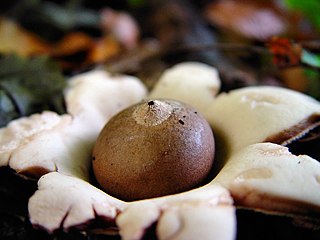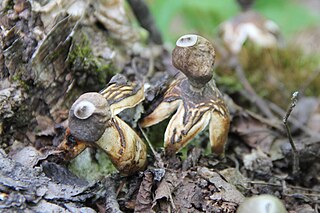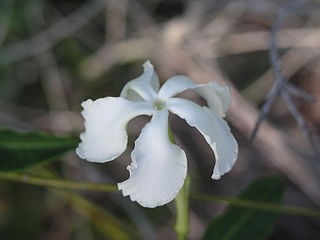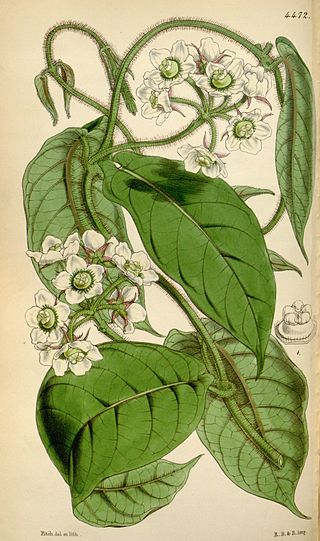
Stanhopea is a genus of the orchid family (Orchidaceae) from Central and South America. The abbreviation used in horticultural trade is Stan. The genus is named for the 4th Earl of Stanhope (1781-1855), president of the Medico-Botanical Society of London (1829-1837). It comprises 55 species and 5 natural hybrids. These epiphytic, but occasionally terrestrial orchids can be found in damp forests from Mexico to Trinidad to NW Argentina. Their ovate pseudobulbs carry from the top one long, plicate, elliptic leaf.

Gongora, abbreviated Gga in horticultural trade, is a member of the orchid family (Orchidaceae). It consists of 65 species known from Central America, Trinidad, and tropical South America, with most species found in Colombia. They grow across a wide geographical range, from wet forests at sea level, to mountainous regions in the Andes, as high as 1,800 m.

Chusquea is a genus of evergreen bamboos in the grass family. Most of them are native to mountain habitats in Latin America, from Mexico to southern Chile and Argentina.

Rhipidocladum is a genus of New World woody bamboo in the grass family. It is found in Mesoamerica, Trinidad, and South America. The genus is characterized by having erect, non-pseudopetiolate culm leaves, numerous branchlets arising in an aspidate (fan-like) array, and by having true caryopses as fruit. The name is derived from the Greek rhipid meaning "fanlike" and clad meaning "branch".
- Rhipidocladum abregoensis - Colombia
- Rhipidocladum ampliflorum - Venezuela
- Rhipidocladum angustiflorum - Colombia, Venezuela
- Rhipidocladum bartlettii - Mexico, Belize, Guatemala, Honduras
- Rhipidocladum clarkiae - Costa Rica
- Rhipidocladum harmonicum - from southern Mexico to Bolivia
- Rhipidocladum martinezii - Mexico (Chiapas)
- Rhipidocladum maxonii - Costa Rica, Guyana
- Rhipidocladum neumannii - Argentina, Bolivia
- Rhipidocladum pacuarense - Nicaragua, Costa Rica
- Rhipidocladum panamense - Panamá
- Rhipidocladum parviflorum - Venezuela, Colombia, Perú, Bolivia, Brazil, Panamá
- Rhipidocladum pittieri - from Mexico (Michoacán) to Panamá
- Rhipidocladum prestoei - Trinidad
- Rhipidocladum racemiflorum - Mexico from Tucumán to Tamaulipas
- Rhipidocladum sibilans - Venezuela, Guyana

Calyptrogyne is a genus in the palm family (Arecaceae). It is distributed across Central America, Colombia, and southern Mexico, with 11 of the 17 known species endemic to Panama. Calyptrogyne ghiesbreghtiana is the most widespread and best studied species in this genus.

Bagheera is a genus of jumping spiders within the family Salticidae, subfamily Salticinae and subtribe Dendryphantina. The genus was first described by George Peckham & Elizabeth Peckham in 1896. The name is derived from Bagheera, a character from Rudyard Kipling's Jungle Book.

The variegated squirrel is a tree squirrel in the genus Sciurus found in Costa Rica, El Salvador, Guatemala, Honduras, southern Mexico, Nicaragua, and Panama. Fifteen subspecies are recognised. It is a common squirrel and the International Union for Conservation of Nature has rated it a "least-concern species". Variegated squirrels kept as pets in Germany have been implicated in the transmission of a bornavirus to humans from which three people have died.

Bourreria is a genus of flowering plants in the borage family, Boraginaceae. Members of the genus are commonly known as strongbark or strongback. The generic name was chosen by Patrick Browne to honour German pharmacist Johann Ambrosius Beurer. The genus is native to the Americas, where species are distributed from Mexico to northern South America, and in the Caribbean and Florida in the United States. The center of diversity is in the Caribbean, Central America, and Mexico.

Brunellia is a genus of trees. They are distributed in the mountainous regions of southern Mexico, Central America, West Indies, and South America. Brunellia is the only genus in the family Brunelliaceae. As of 2001 there were about 54 species.

Hoffmannia is a genus of flowering plants in the family Rubiaceae. They are distributed in Mexico, Central America, and South America.

Geastrum is a genus of puffball-like mushrooms in the family Geastraceae. Many species are commonly known as earthstars.

Geastrum saccatum, commonly known as the rounded earthstar, is a species of mushroom belonging to the genus Geastrum. It has a worldwide distribution and is found growing on rotting wood. It is considered inedible by mushroomers because of its bitter taste. It is a common mushroom, but collections are at their peak during late summer. The opening of the outer layer of the fruiting body in the characteristic star shape is thought to be due to a buildup of calcium oxalate crystals immediately prior to dehiscence. G. saccatum is distinguished from other earthstars by the distinct circular ridge or depression surrounding the central pore. In Brazil, its common name translates to "star of the land".

Geastrum fimbriatum, commonly known as the fringed earthstar or the sessile earthstar, is an inedible species of mushroom belonging to the genus Geastrum, or earthstar fungi. First described in 1829, the species has a widespread distribution, and is found in Asia, Europe, and the Americas. It is distinguished from other earthstars by the delicate fibers that line the circular pore at the top of its spore sac.

Geastrum pectinatum is an inedible species of mushroom belonging to the earthstar family of fungi. Although young specimens are spherical, fruit body development involves the outer layer of tissue splitting open like a star into 7 to 10 pointed rays that eventually bend back to point downward, revealing a small – 1 to 2.5 cm broad – spore sac. The spore sac is supported by a small radially wrinkled stalk. There is a distinct conical opening (peristome) at the top of the spore sac that is up to 8 mm (0.3 in) long. It is commonly known as the beaked earthstar or the beret earthstar, in reference to the shape of the spore sac and its prominent, protruding peristome. The mass of spores and surrounding cells within the sac, the gleba, is dark-brown, and becomes powdery in mature specimens. Spores are spherical, measuring 4 to 6 micrometers in diameter, with warts on their surfaces. Although uncommon, Geastrum pectinatum has a cosmopolitan distribution, and has been collected in various locations in Europe, North and South America, Asia, Australia and Africa, where it grows on the ground in open woods. Like several other earthstars, crystals of calcium oxalate are found on G. pectinatum, and are thought to be involved in fruit body maturation.

Geastrum triplex is a fungus found in the detritus and leaf litter of hardwood forests around the world. It is commonly known as the collared earthstar, the saucered earthstar, or the triple earthstar—and less commonly by the alternative species name Geastrum indicum. It is the largest member of the genus Geastrum and expanded mature specimens can reach a tip-to-tip length of up to 12 centimeters (4.7 in).

Geastrum quadrifidum, commonly known as the rayed earthstar or four-footed earthstar, is an inedible species of mushroom belonging to the genus Geastrum, or earthstar fungi. First described scientifically by Christian Hendrik Persoon in 1794, G. quadrifidum is a cosmopolitan—but not common—species of Europe, the Americas, Africa, Asia, and Australasia. The fungus is a saprobe, feeding off decomposing organic matter present in the soil and litter of coniferous forests.

Pittieria aurantiaca is a species of predatory air-breathing land snail, a terrestrial pulmonate gastropod mollusk in the family Spiraxidae.

Echites is a genus of flowering plants in the family Apocynaceae, first described as a genus in 1756. It is primarily native to Mexico, Central America, the West Indies, and the US State of Florida.

Fischeria is a plant genus in the family Apocynaceae, first described as a genus in 1813. It is native to South America, Central America, southern Mexico, and the West Indies.

Sericopelma is a genus of tarantula, found in Central America from Nicaragua to Panama. The limits of the genus and its distribution have long been confused; it is closely related to the genus Aphonopelma. Sericopelma species are among the largest found in Central America. They can be kept as pets, although at least one species has been described as "very aggressive".




















